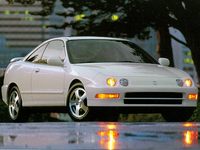1994 ACURA INTEGRA GS-R SPORT COUPE REVIEW
by: BILL RUSS
SEE ALSO:Acura Buyer's Guide
Since it first appeared almost eight years ago, the Integra has been Acura's popularly-priced sports coupe. There is an all-new third- generation Integra for 1994, with new body styling, a new engine, revised suspension, and improved structural rigidity. The top-line GS-R is our test car for this week. It is truly a technological masterpiece containing many high-tech features gleaned from Honda's Formula One experiences, as well as those utilized in the development and building of the NSX sports coupe. The 1994 Acura GS-R now delivers the highest specific power output of any non-turbocharged car currently available in the American market. If you are interested in the application of Formula One technology in your next car you'll love the latest GS-R.
APPEARANCE: The new Intergra displays the fresh clean appearance of sports cars in the '90's. From the front its distinctive rounded wedge shape starts with a low nose and sweeps back to the short high rear deck that is topped off by spoiler. Four projector-style headlights and a wide air intake below the integrated bumper highlight the front. Access to the largely glass cabin is via wide opening doors, as well as a large rear hatch which is outfitted with washer/wiper and defogger. An outer-opening tilt and slide glass sunroof is standard equipment as are five-spoke alloy wheels and low-profile Michelin speed-rated all-season tires.
COMFORT: The GS-R is delivered so completely equipped that the only option appearing on the window sticker is floor mats. The six- speaker AM/FM/cassette combination provides excellent sound in the cabin, while the heater/airconditioner quietly maintains a comfortable temperature. The cloth-covered deep front bucket seats snugly and comfortably hold the driver and passenger in place. The small rear seat backs fold down flat when added cargo space is needed, and for security can be locked in the upright position. For easy back seat access the front passenger seat slides forward when tilted forward. Seat belt buckles are now attached to the seats to make them easier to use. Power side mirrors, front door windows and locks are powered. All instruments and controls are where they should be, but it would be easier to use the radio if it were mounted higher on the console.
ROADABILITY: The new Integra is an even better road car than its predecessor. Fine tuning its time-proven double-wishbone suspension smoothes out its ride qualities. A new improved power assisted steering system provides almost neutral steering. The use of Michelin P195/55R15 speed rated all-season tires delivers excellent surface- holding characteristics. Its new stronger body reduces noise and vibration for a quieter drive down the road. Added together these improvements and additions give the 1994 Integra GS-R true sports car handling. Safety is enhanced by the use of dual front air bags, three- point seat belts, side impact door beams, five mile per hour bumpers and energy absorbing side door panels. Four-wheel disc brakes and the anti-lock braking system insure straight and safe stopping in most weather conditions. The newest GS-R delivers a balanced controlled ride.
PERFORMANCE: Along with all the other improvements and additions, the use of race-originated technology has resulted in increased engine displacement, power and fuel economy. A prominent example is the use of Hondas' VTEC system. VTEC stands for Variable Valve Timing and Lift Electronic Control. Simply put, this system automatically adjusts valve timing, lift and duration to achieve the very desirable combination of low rpm torque and high rpm power which is not possible in most conventional engines. This and a new dual-stage intake manifold plus an additional 119 cubic centimeter of displacement combine to add 10 additional horsepower and one mile-per-gallon to the EPA ratings. These engineering changes provide a broad power band, which means that more usable power is available at normal speeds. To maintain its sports car image, only a slick-shifting, close-ratio, five-speed manual transmission especially designed to match the engines' performance characteristics can be had on the GS-R.
CONCLUSIONS: The Acura Integra is more than a sports car. It is a comprehensive display demonstrating how the old adage: " win on Sunday, sell on Monday" can still be applied to todays' production cars. It is the engineering, suspension, combustion and safety technology learned from winning professional racing experiences which can practically be applied to production showroom cars that makes this car much more than just a styling experience.
SPECIFICATIONS:
1994 ACURA INTEGRA GS-R SPORT COUPE
Base Price $ 19,440
Price As Tested $ 19,894
Engine Type I-4, dohc - 16v, mpfi, VTEC
Engine Size 1.8 liter/109 cid
Horsepower 170 @ 7600
Torque (ft/lbs) 128 @ 6200
Wheelbase/Length 101"/172"
Transmission five speed manual w/od
Curb Weight 2690
Pounds per Horsepower 16
Fuel Capacity 13
Fuel Requirement Unleaded premium (91 oct)
Tires Michelin XGT-V4 P195/55R15 84V M+S
Brakes anti-lock standard disc/disc
Drive Train front engine/front drive
PERFORMANCE
EPA Economy - miles per gallon,
city/highway/observed 25/31/26.1
0 to 60 mph 6.7 sec
1/4 mi (E.T.) 15.4 sec
Coefficient of Drag (Cd) .33



